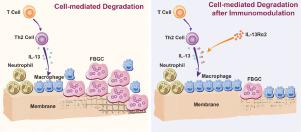当前位置:
X-MOL 学术
›
Acta Biomater.
›
论文详情
Our official English website, www.x-mol.net, welcomes your
feedback! (Note: you will need to create a separate account there.)
Tuning the immune reaction to manipulate the cell-mediated degradation of a collagen barrier membrane.
Acta Biomaterialia ( IF 9.4 ) Pub Date : 2020-04-06 , DOI: 10.1016/j.actbio.2020.03.038 Jinghan Fang 1 , Runheng Liu 1 , Shoucheng Chen 1 , Quan Liu 1 , Huaxiong Cai 1 , Yixiong Lin 2 , Zetao Chen 2 , Zhuofan Chen 1
Acta Biomaterialia ( IF 9.4 ) Pub Date : 2020-04-06 , DOI: 10.1016/j.actbio.2020.03.038 Jinghan Fang 1 , Runheng Liu 1 , Shoucheng Chen 1 , Quan Liu 1 , Huaxiong Cai 1 , Yixiong Lin 2 , Zetao Chen 2 , Zhuofan Chen 1
Affiliation

|
In order to elicit a desired barrier function in guided bone regeneration (GBR) or guided tissue regeneration (GTR), a barrier membrane has to maintain its integrity for a certain period of time to guarantee the regeneration of target tissue. Due to the complexity and variety of clinical conditions, the healing time required for tissue regeneration varies from one case to another, which implies the need for tailoring the barrier membranes to diverse conditions via manipulating their degradation property. As a "non-self" biomaterial, a barrier membrane will inevitably trigger host-membrane immune response after implantation, which entails the activation of phagocytic cells. In the degradation process of a barrier membrane, the cell-mediated degradation may play a more vital role than enzymatic and physicochemical dissolution; however, limited studies have been carried out on this topic. In this context, we investigated the cell-mediated degradation and illustrated the possible key cells and mediators for immunomodulation via in vivo and in vitro studies. We discovered that IL-13, a key cytokine mainly released by T helper 2 cells (Th2), induced the formation of foreign body giant cells (FBGCs), thus resulting in membrane degradation. Neutralizing IL-13 could suppress membrane degradation and formation of FBGC. The contributions of this study are (1) unveiling the immune mechanisms underlying the cell-mediated collagen membrane degradation; (2) allowing the formation of an "immunodegradation" strategy to develop an "immune-smart" barrier membrane to manipulate its degradation; (3) providing the key regulatory immune cells and cytokines for the immunomodulation target in collagen membrane degradation. STATEMENT OF SIGNIFICANCE: The significance of this research includes.
中文翻译:

调节免疫反应,以控制细胞介导的胶原屏障膜降解。
为了在引导的骨再生(GBR)或引导的组织再生(GTR)中引发所需的屏障功能,屏障膜必须在一段时间内保持其完整性,以确保目标组织的再生。由于临床条件的复杂性和多样性,组织再生所需的愈合时间因情况而异,这意味着需要通过操纵其降解特性使屏障膜适应各种情况。作为“非自我”生物材料,屏障膜在植入后将不可避免地触发宿主膜免疫反应,这需要吞噬细胞的激活。在屏障膜的降解过程中,细胞介导的降解可能比酶和物理化学溶解更重要。然而,关于这个主题已经进行了有限的研究。在这种情况下,我们调查了细胞介导的降解,并说明了可能通过体内和体外研究进行免疫调节的关键细胞和介体。我们发现IL-13是主要由T辅助2细胞(Th2)释放的关键细胞因子,可诱导异物巨细胞(FBGC)的形成,从而导致膜降解。中和IL-13可以抑制膜降解和FBGC的形成。这项研究的贡献是(1)揭示了细胞介导的胶原膜降解的免疫机制;(2)允许形成“免疫降解”策略,以开发“免疫智能”屏障膜来控制其降解;(3)为胶原膜降解中的免疫调节靶标提供关键的调节免疫细胞和细胞因子。意义声明:这项研究的意义包括。
更新日期:2020-04-06
中文翻译:

调节免疫反应,以控制细胞介导的胶原屏障膜降解。
为了在引导的骨再生(GBR)或引导的组织再生(GTR)中引发所需的屏障功能,屏障膜必须在一段时间内保持其完整性,以确保目标组织的再生。由于临床条件的复杂性和多样性,组织再生所需的愈合时间因情况而异,这意味着需要通过操纵其降解特性使屏障膜适应各种情况。作为“非自我”生物材料,屏障膜在植入后将不可避免地触发宿主膜免疫反应,这需要吞噬细胞的激活。在屏障膜的降解过程中,细胞介导的降解可能比酶和物理化学溶解更重要。然而,关于这个主题已经进行了有限的研究。在这种情况下,我们调查了细胞介导的降解,并说明了可能通过体内和体外研究进行免疫调节的关键细胞和介体。我们发现IL-13是主要由T辅助2细胞(Th2)释放的关键细胞因子,可诱导异物巨细胞(FBGC)的形成,从而导致膜降解。中和IL-13可以抑制膜降解和FBGC的形成。这项研究的贡献是(1)揭示了细胞介导的胶原膜降解的免疫机制;(2)允许形成“免疫降解”策略,以开发“免疫智能”屏障膜来控制其降解;(3)为胶原膜降解中的免疫调节靶标提供关键的调节免疫细胞和细胞因子。意义声明:这项研究的意义包括。











































 京公网安备 11010802027423号
京公网安备 11010802027423号